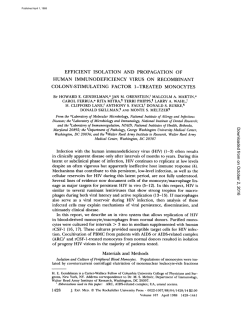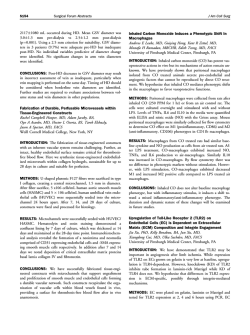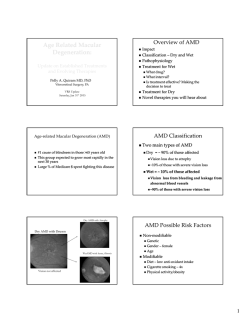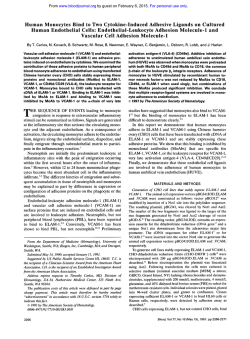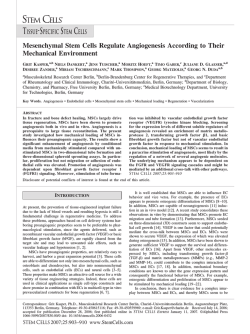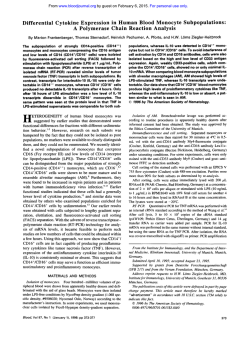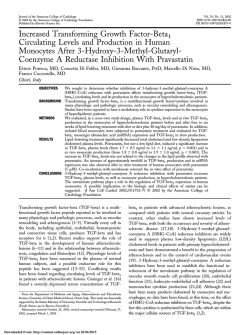
Migration of Human Monocytes in Response to Vascular
From www.bloodjournal.org by guest on February 6, 2015. For personal use only. Migration of Human Monocytes in Response to Vascular Endothelial Growth Factor (VEGF) Is Mediated via the VEGF Receptor flt-1 By Bernhard Barleon, Silvano Sozzani, Dan Zhou, Herbert A. Weich, Alberto Mantovani, and Dieter Marme Treatment of human monocytes with vascular endothelial growth factor (VEGF) isolated from tumor cell supernatants was reported t o induce monocyte activation and migration. In this study we show that recombinant human VEGFle6 and VEGF,, had a maximal effect on human monocyte migration was at 65 t o 250 pmol/L. Chemotactic activity of VEGF,, inhibited by a specific antiserum against VEGF, by heat treatment of VEGFle6, and by protein kinase inhibitors. In addition, we could show that VEGF-stimulated monocyte migration is mediated by a pertussis toxin-sensitive GTP-binding protein. Placenta growth factor (PIGFIU), a heparin-binding growth factor related t o VEGF, was also chemotactic for monocytes at concentrations between 2.5 and 25 pmol/L. In accordance with these findings, human monocytes showed specific and saturable binding for '251-VEGFls6 (half-maximal binding at 1 t o 1.5 nmol/L). Using Northern blot analysis, we further could show that human monocytes express only the gene for the VEGF receptor type, flt-1, but not for the second known VEGF receptor, KDR. Resting monocytes expressed low levels of flt-1 gene only. Brief exposure (2 t o 4 hours) of human monocytes t o lipopolysaccharids, a prototypic monocyte activator, led t o a significant upregulation of the flt-1 mRNA level. The results presented here suggest that monocyte chemotaxis in response t o VEGF and most likely t o PlGF19 is mediated by flt-1 and thus show a possible function for the VEGF-receptor flt-1. 0 1996 by The American Society of Hematology. R ECRUITMENT OF mononuclear phagocytes from the blood compartment into tissues is a crucial process in inflammatory reactions and immune response. Monocyte extravasation involves interaction with the vascular endothelium and response to tissue- and/or vessel wall-derived molecules. The identification of adhesion molecules, whose expression is upregulated on endothelial cells, and of novel cytokines has considerably improved the understanding of factors involved in the regulation of monocyte migration, localization, and activation in tissues. Vascular endothelial growth factor (VEGF) is a mitogen specific for endothelial cells. VEGF has been discovered in and purified from media conditioned by several tumor cell lines and bovine pituitary folliculo-stellate cells. Molecular cloning of the cDNA suggests that in human cells at least four species of VEGF can occur as 121, 165, 189, and 206 amino acid forms, generated by alternative splicing (for a review, see Senger et all). It has been shown that VEGFlhS induces monocyte activation manifested by the induction of tissue factor and monocyte chemotaxis.' Another growth factor, related to the VEGF family, is the recently identified placenta growth factor (PIGF), of which two forms, PIGF,,, and P1GFIs2, are known so far. The overall homology between the amino acid sequences of P1GFlS2and VEGF189is about 40%, but, if the conservative amino acid changes are considered, the sequence homology increases to about 67%. Like VEGF, PlGF is a secreted, dimeric, and N-glycosylated pr~tein.'.~ Because of the structural and biochemical similarities between VEGF and PlGF, it was suggested that the latter might also be an angiogenic f a ~ t o r .However, ~ the physiologic functions of PlGF are almost completely unknown. High-affinity binding sites for VEGF were mainly found on endothelial c e k 5 Recently, Shen et al' could show highaffinity binding sites for VEGFlh on human mononuclear phagocytes indicating the expression of a VEGF receptor gene. Two receptor tyrosine kinases encoded by the flt- 1 gene7,xand KDWflk-l gene','" have been identified as specific VEGF receptors. Expression of flt-1 and KDFUflk- 1 was predominantly found in vascular endothelial cells.' ' KDW flk- 1, when transfected into endothelial cells or nonendothelial cells, mediates proliferating activity.'"," The function of the second VEGF receptor, flt-1, remains unclear since flt1 transfected cells did not show proliferation or other responses upon exposure to VEGF."." A third member of the VEGF-receptor subfamily is the recently cloned receptor tyrosine kinase Flt-4,I4 but the ligand for this receptor is not yet clearly identified. In this study, we have investigated the chemotactic properties of VEGFlhSrVEGFlzl,and PlGFls2on human monocytes and found that all three growth factors induce migration in a dose-dependent manner. Moreover, we show, for the first time, that the VEGF-induced chemotactic response on human monocytes is mediated via the VEGF-receptor flt-1. From the Institute of Molecular Medicine, Tumor Biology Center, Freiburg, Germany; the Department of Gene Expression, Braunschweig, Germany; and the Institut di Ricerche Farmacologiche Mario Negri, Milan, Italy. Submitted June 30, 1995: accepted December 6, 1995. B.B. and S.S. contributed equally to this work. Address reprint requests to Dieter Marmi, PhD, Institute of Molecular Medicine, Tumor Biology Center, Breisacherstr. 1 17, D79106 Freiburg, Germany. The publication costs of this article were defrayed in part by page charge payment. This article must therefore be hereby marked ''advertisement'' in accordance with 18 U.S.C. section 1734 solely to indicute this fact. 0 1996 bv The American Society of Hematology. Reagents. Human recombinant VEGF,6s, VEGF,,,, and PIGFls2 were expressed in the baculovirus system, purified, and tested for biologic activity as described.'.l5 fMLP was from Sigma Chemical Co (St Louis, MO). C-I was a kind gift from Dr C.E. McCall (Bowman Gray School of Medicine, Winston-Salem, NC). Genistein and pertussis toxin (PTox) were from Calbiochem (San Diego, CA). Bacterial lipopolysaccharid (LPS D,, Escherichia coli 055:B5) was from Difco Labs (Detroit, MI). Cell lines. Primary human umbilical vein endothelial cells (HUVEC) were purchased from Promocell (Heidelberg, Germany) and cultured according to the provided protocol. Human smooth muscle cells were isolated and cultured as described." Isolation of humun monocytes and neutrophils (PMN). Peripheral blood mononuclear cells (PBMC) were obtained from buffy coats of blood from normal donors courtesy of the Transfu- MATERIALS AND METHODS 0006-4971/96/8708-0028$3.00/0 3336 Blood, Vol 87, No 8 (April 15), 1996:pp 3336-3343 From www.bloodjournal.org by guest on February 6, 2015. For personal use only. 3337 VEGF-INDUCED MIGRATION OF MONOCYTES VIA FLT-1 sionsmedizin, University Hospital (Freiburg, Germany) and the Centro Transfusionale, Ospedale Sacco (Milan, Italy). Isolation was performed as described," and the viability of the cells was checked by trypan blue exclusion immediately before the experiments (> 95%). Chemotaxis assay. Cell migration was evaluated using a microchamber technique as de~cribed.'~,'~ Chemoattractant (27 ? 1 pL) in RPMI-1640 with 1% fetal calf serum (FCS) was added to the lower wells of a chemotaxis chamber (Nucleopore Corp, Pleasanton, CA). Fifty microliters of cell suspension per well (1.5 X 106/mL monocytes in PBMC, or PMN) were seeded in the upper wells. The upper and lower wells were separated by a 5-pm pore size polycarbonate filter (Nucleopore). Polyvinylpyrrolidone-free polycarbonate filters were used for PMN. The chambers were incubated at 37°C in air with 5% CO, for 60 and 90 minutes for PMN and monocytes, respectively. At the end of incubation, filters were removed and stained with Diff-Quik (Harleco, Gibbstown, NJ), and five high power oil immersion fields were counted. In some experiments, a specific rabbit antipeptide antiserum for VEGF" was used to adsorb the cytokine. Four hundred microliters of 10% Sepharose protein G was incubated with 60 pL of anti-VEGF antibody (diluted 1:3 in phosphate-buffered saline [PBS]) at 4°C for 30 minutes. Sepharose was then washed 3 x with PBS and 100 pL of 10 ng/mL VEGF165was added to the pellet and incubated at 4°C for 1 hour. The supematants were then collected and used in the chemotaxis assay. In some experiments, monocytes (1.5 X 106/mL in PBMC) were preincubated with different concentrations of PTox at 37°C for 90 minutes. The cells were then washed twice, resuspended in RPMI 1% FCS, and tested in the migration assay. VEGF receptor binding assay. Binding experiments were performed with recombinant human VEGF165on human monocytes. The cells were resuspended in ice-cold binding buffer (Dulbecco's modified Eagle's medium [DMEM], 25 mmol/L HEPES, 1 mg/mL bovine serum albumin, pH 7.4) at a density of 2.5 to 6 X IO6 cells/ mL. One hundred microliters of the cell suspension was plated on a 48-well culture disk (with flat bottom). After adding the labeled and unlabeled VEGF165rthe final volume was 200 pL per well. The binding was performed for 3 hours on ice with increasing concentrations of 'Z51-VEGF165.1' Unspecific binding was determined for each concentration by the addition of a 100-fold excess of unlabeled ligand. For competition assays, the cells were incubated with a constant concentration of 1251-VEGF165 (20 ng/mL) and increasing amounts of purified recombinant human VEGF or PlGF. Cells were washed extensively with binding buffer and then solubilized with 0.3 m o m NaOH, 0.1% sodium dodecyl sulfate (SDS). Radioactivity present in the lysates was quantified using a gamma counter (Beckmann, Munchen, Germany). Recombinant human VEGF165was iodinated to 30,000 to 136,000 cpm/ng using the chloramin T method." Northern blot analysis. Total RNA was prepared from cells and human placental tissue by a guanidinekaesium chloride centrifugation method'" or by a modification of the acid guanidine thiocyanatephenol-chloroform extraction protocol." Northern blot analysis was performed as described." For the flt-1 gene, hybridization was performed with a 1.05-kb cDNA fragment corresponding to a part of the extracellular domain (nucleotide 172-1231) of the human cDNA For KDR, hybridization was performed with a 1.4-kb ~equence.~." cDNA fragment corresponding to a part of the extracellular domain (nucleotide 360-1720) of the human cDNA sequence? For FLT-4, hybridization was performed with a 1.2-kb cDNA fragment that covers the transmembrane part, the full kinase domain, and a part of the C-terminus (nucleotide 2534-3788).14 RESULTS Chemotactic properties of VEGFIGs, VEGFI2], and P1GFlS2. A first series of experiments was designed to char- Table 1. Chemotactic Activity of VEGFla on Human Monocytes and PMN Migrated Cells PMN Monocytes Control Cell No. 96 Cell No. % 21 t 1 100 40 t 2 100 31 t 3 51 ? 3* 81 -C 4* 71 t 3* 107 t 3* 147 242 385 338 509 40 t 6 41 t 4 63 t 4* 43 t 7 103 ? 2' 100 102 157 107 257 VEGFle5 (ng/mL) 0.1 1 10 100 fMLP ( I O nmol/L) Different concentrations of VEGFls5 were supplied to the lower compartment of the chemotaxis chamber. The results are mean numbers (?SDI of migrated cells in five oil fields. Each experiment was performed in triplicate. P < .05 v migration to control medium. acterize the chemotactic properties of VEGF165.Table 1 shows that VEGF165was able to induce migration of monocytes across polycarbonate filters in a dose-dependent manner. The maximal response was obtained at a concentration of 220 pmoVL. At this concentration, the number of migrated monocytes was about 65% of that observed with an optimal concentration of fMLP (10 nmoVL) that was used as a reference chemoattractant, active on all leukocyte populations. Table 1 also shows that, under similar experimental conditions, VEGF165was able to induce migration of PMN. The dose-response curve obtained with PMN was sharper than that observed with monocytes, although maximal migration was obtained at the same concentration. At 220 pmoVL VEGF165,PMN migration was about 45% of the response observed in the presence of 10 nmoVL fLMP. Heat-inactivated VEGF165,as well as VEGF165preadsorbed on Sepharose-protein G beads coated with anti-VEGF antiserum, were inactive (Fig 1A). These results indicate that vEGF165is able to elicit a migratory response in human monocytes and PMN. To clarify whether the migration of monocytes across filters depends on the presence of a VEGF165gradient between the lower and the upper compartment, we performed checkerboard experiments using polycarbonate filters with the number of migrated cells as the end point. As shown in Table 2, maximal induction of migration occurred in the presence of a positive concentration gradient between the two compartments (higher concentration below the filter). In the presence of equal concentrations of VEGF,,, above and below the filter or of a negative gradient (higher concentration above the filter), no enhanced migration occurred. These results indicate that VEGF165is able to activate a chemotactic response in human monocytes with no appreciable chemokinetic activity. The mechanism(s) involved in the induction of monocyte chemotaxis after VEGF165stimulation is unknown. The involvement of protein kinases was investigated by using inhibitors. Figure 1B shows that both C-I and genistein, inhibitors of threoninelserine kinases and tyrosine kinases, respectively, cause a dose-dependent inhibition of monocyte From www.bloodjournal.org by guest on February 6, 2015. For personal use only. 3338 BARLEON ET AL A I b C-I 1001 40 0 c 0 20 Control I-I Anti-VEGF " Preimmune serum Boiled VEGF 0 .1 1 10 100 1000 Inhibitors, uM Fig 1. Effect of anti-VEGF antiserum, heat treatment, and protein kinase inhibitors on the monocyte chemotactic response to VEGFls6. (A) Monocytes (1.5 x 10'lmL) were teated for their ability to migrate in response to 10 nglmL VEGFlffi preincubated with Sepharose-protein G beads precoated with rabbit anti-VEGF antiserum (column 2) or preimmune serum (column 3). In column 4 the response to 10 ng/mL VEGFlw boiled for 30 minutes is shown. Chemotactic activity is expresred as a percentage of monocyte migration at 10 ng/mL VEGFlw (column 1). (B) Monocytes were preincubated at 37°C for 10 minutes with different concentrations of the inhibitors and then tested for their ability to migrate in response to 10 nglmL VEGFlffi. Values represent the mean of three separate experiments ( S D ) and are expressed as a percentage of the migration observed in the absence of inhibitors and in the presence of the respective solvents (saline and 0.01% DMSO for C-l and genidein, respectively). Cell viability at the end of the assay was greater than 90%. migration. Half-maximal inhibition was observed at 25 pmol/L for C-I and 0.4 pmol/L for genistein. Chemotaxis induced by fLMP was blocked by similar concentrations of both inhibitors (data not shown). Stimulation with KMP, which acts through a seven-transmembrane domain receptor,23induces tyrosine phosphorylation, and this event appears to be important for the induction of cell migrati~n.'~ It was recently reported that the bFGF-induced chemotactic response in bovine aortic endothelial cells is mediated by a pertussis toxin-sensitive GTP-binding protein.25We investigated the effect of PTox on VEGF-mediated human monocyte migration. Cells were preincubated with increasing concentrations of PTox and stimulated with optimal concentration of chemoattractants. As shown in Fig 2, VEGF- and fMLP-induced chemotactic responses were blocked in a dose-dependent manner by PTox, whereas that Table 2. Checkerboard Analysis of VEGFlw Stimulation of Monocvte Migration Lower Compartment Upper Compartment VEGFqS6Ing/mL) None None 0.1 1 10 37 2 2 72 2 5* 79 2 2 t 11423t 0.1 38 2 43 2 41 2 46t 2 6 3 2t 1 10 36 c 2 3922 3422 3623 29 2 2* 3123 3255 37 2 4 Different concentrations of VEGF,= (in nanograms per milliliter) were supplied to the upper and/or lower compartment of the chemoof migrated cells taxis chamber. The results are mean numbers (+SD) in five oil fields. Each experiment was performed in triplicate. * P < .05 v migration to control medium (above and below the filter). t P c .01 v migration to control medium (above and below the filter). of phorbol 12-myristate 13-acetate (PMA) was unaffected. This result suggests that the VEGF-induced migration of human monocytes is mediated via a pertussis toxin-sensitive GTP-binding protein. We further compared the chemotactic properties of VEGFIZland of the VEGF-related growth factor P1GFjS2 with those of VEGF165described above. Table 3 shows that VEGF,,, as well as P1GF152were able to induce migration of monocytes. The maximal response to VEGF,,, was observed at 65 pmol/L and to P1GF152at 7 pmoVL. At these concentrations, the percentage of migrated monocytes was about 50% for VEGF,,, and about 40% for P1GF152of that observed at 10 nmol/L d M P . Although the maximal effects to VEGFIzIand P1GF152were observed at lower concentrations as compared with VEGF165(65 pmol/L and 7 pmol/L, respectively, as compared with 220 pmol/L), both factors had a lower efficacy than VEGF165in that they induced the migration of less cells. Expression of VEGF receptors in human monocytes. The presence of specific binding sites for '*'I-VEGFlh5on human monocytes was investigated. In six different experiments we observed specific binding of VEGF165in the range of 60% to 80% of total binding (Fig 3). Half-maximal binding occured at 1 to 1.5 nmol/L, which is 20-to 25-fold lower than that observed for endothelial cells and threefold to fivefold lower than that observed on human monocytes by Shen et al.h Because VEGF binds to and induces migration of monocytes, it was of interest which of the two known VEGF receptors is involved. Therefore, we performed Northern blot analysis of total RNA from human monocytes and PMNs using human cDNA sequences appropriate for the two VEGF receptors flt-1 and KDR as well as for the related receptor, FLT-4. The result is shown in Fig 4. Resting human monocytes express detectable levels of flt-1 mRNA but not of KDR and Flt-4. The expression pattern of flt-1 is slightly From www.bloodjournal.org by guest on February 6, 2015. For personal use only. 3339 VEGF-INDUCED MIGRATION OF MONOCYTES VIA FLT-1 Table 3. Chemotactic Activity of VEGFlzl and PIGFlE2 on Human Monocytes I ~ Migrated Cells Cell No. Control VEGF,,, (nglmL) 1 3 10 50 PIGFIs2 (ng/mL) 0.03 0.1 0.3 1 fMLP (10 nmol/L) "0 10 1 100 1000 PTox (ng/ml) Fig 2. Effect of PTox pretreatment on monocyte chemotaxis in response to VEGF,,. Monocytes (1.5 x 106/mL in PBMC) were incubated with different concentrations of PTox at 37°C for 90 minutes. Cells were then washed twice, resuspendend in RPMl 1% FCS, and tested in the migration assay. Chemoattractantr were used at their optimal concentration: 220 pmol/L VEGFlss, 10 nmol/L fMLP, and 16 nmol/L PMA. Migration of monocytes incubated in the absence of PTox was assumed to be 100% (42 2.90 3, and 51 f 4for VEGF,,, fMLP, and PMA, respectively). Values are the means (+SD) of three seperate experiments (each performed in triplicate) and are expressed as a percentage of activity. * * different from that obtained with placental tissue and with HUVECs." Three mRNA species of 7.5, 3.4, and 2.7 kb, similar to those from placenta, could be detected. However, in contrast to human placental tissue, in which the 3.4-kb mRNA species is the dominant one, in monocytes the 2.7kb and 7.5-kb transcripts are the dominant mRNA species, with a similar expression level. The 2.7-kb mRNA transcript is too short to code for the full-length receptor mRNA and probably encodes a truncated form of flt-l.26 Similar to monocytes, PMNs also express only the gene for the flt-1 receptor type, but the expression is much weaker than that observed in monocytes. PMNs show flt-1 transcripts of 7.5 kb and 2.7 kb but lack the 3.4-kb mRNA species (Fig 4). PlCF is believed to act via the VEGF receptor flt-1. It has been shown that PlGF binds to flt-127.28 and competes with VEGF binding to flt-l",28 (Barleon and Martiny-Baron, unpublished data). We performed competition experiments with 1251-VEGF16s and P1GFIs2on human monocytes. Figure 5 shows the results. P1GF152is able to compete for the binding of 1251-VEGF165 with a similar efficiency as unlabeled VEGF16s. Taken together, these data indicate that the VEGF receptor flt-1 is expressed in human monocytes and PMNs and that both VEGF and PlGF bind to this receptor. Thus, it is likely that both factors induce the chemotactic response by activating the VEGF receptor flt-1. To investigate whether flt-1 gene expression in human monocytes is upregulated by LPS, a prototypic monocyte % 28 t 4 100 38 45 40 38 t 3' t 2t 2 2 135 160 142 135 43 c 3 t 46 t 2 t 37 2 I t 29 2 3 94 c 2 153 164 132 103 335 2 4 Different concentrations of VEGF,,, and PIGFlS2 were supplied t o the lower compartment of the chemotaxis chamber. The results are means number (cSD) of migrated cells in five oil fields. Each experiment was performed i n triplicate. * P > .01. t P > .05. activator:' monocytes were exposed to 100 ng/mL LPS for 2 to 4 hours. Figure 6 shows that flt-1 transcripts increase after just 2 hours of stimulation; this stimulation was dose dependent (data not shown). In preliminary experiments, we observed that 16 hours of incubation of monocytes with 100 nglmL LPS resulted in a 1.5-fold to twofold increase in specific binding of L251-VEGF165 as compared with untreated cells. The calculated half-maximal binding was 0.4 to 0.6 nmol/L for LPS-treated and 1 to 1.5 nmoVL for untreated monocytes. In addition, LPS-incubated monocytes showed an increased ability to migrate in response to suboptimal concentrations of VEGF165(data not shown). Taken together, our results indicate that, in human monocytes, the migration signal induced by VEGF and most prob- total binding 150A 0 specific binding unspecific binding C 1) gs m F j 1000,x % E 82 ,$ 5 0 c? 0 0 50 100 '2sI-VEGF16s 150 (ng/ml) 200 Fig 3. '261-VEGFl~ binding to human monocytes.Bindingwas performed on 6 x 10' cells in 48-well plat- for 3 houm at 4°C in the presence of increaaing concentrationsof '9-VEGFl,. The nonspocific binding was determined by adding 100-fold excess of unbbeled VEGF,,. From www.bloodjournal.org by guest on February 6, 2015. For personal use only. BARLEON ET AL 3340 A I (kW 7.5 * 28s - 3.4 2.7 18s (kb) Otb) 5.8 * 28 s - 4.5 * * - 18s- Fig 4. Expression of VEGF receptors in human monocytes and PMNs. Five micrograms of total RNA per lane was separated on an agarose gel, transferred t o a nitrocellulose filter, and hybridized with specific cDNA probes. Lane 1, human neutrophils (PMNs); lane 2,human monocytes; lane 3, human placenta; lane 4, HUVEC; lane 5, human smooth muscle cells (SMC). (A) For flt-1, hybridization was performed with a 1.05-kb cDNA fragment. (B) For KDR, hybridization was performed with a 1.4-kb cDNA fragment. (C) For FLT-4, hybridization was performed with a 1.2-kb cDNA fragment. Exposure time was 7 days for flt-1 and 9 days for KDR and FLT-4 (with amplifier screen). ably also that induced by PIGFIs2is mediated via the flt-l receptor and, secondly, activation of human monocytes by LPS causes a significant upregulation of the flt-1 mRNA level and an increase of specific binding for VEGF. DISCUSSION Wound repair and immune response are essential biologic processes that are driven by the cooperative interaction of multiple cell types and mediator systems. The main cell types seen in inflammatory responses are polymorphonuclear neutrophilic leukocytes together with macrophages and their precursor monocytes. Although numerous cell types are involved, monocyte-derived macrophages appear to play a piv- I 20‘ 0 100 150 200 250 Factor (fold-excess) 50 Fig 5. Competition of ’261-VEGF,ss binding t o human monocytes by VEGFlss and PIGFlS2. Binding was performed on 2.5 x lo5 cells in 24-well plates for 3 hours at 4°C in the presence of a constant concentrations of “51-VEGFlss (20 ng/mL) and increasing amounts of recombinant VEGFlss and PIGF152. otal role in modulating the repair process. Although the role of macrophages in wound repair is certainly multi-functional, several lines of evidence show that they are key regulators of new capillary growth or angiogenesis.’”,” Previous studies have shown that VEGF165 induces directed migration of mononuclear phagocytes across an endothelial cell monolayer as well as their activation based on expression of tissue factor procoagulant activity.’.‘ For VEGFlh5,we observed a maximal response in migration of human monocytes at 220 pmol/L, which is in the same range as reported by Clauss et al’ and Shen et a1.6 Checkerboard experiments with VEGFI6.(clearly showed that the migration depends on the presence of a VEGFlhs gradient. VEGFlos also induced a chemotactic response in PMNs but seems to be less active on these cells. PMNs are another nonspecific inflammatory cell type attracted in the early phase of an acute inflammatory process. These results indicate that VEGF is able to act on the two main cell types seen in inflammatory responses. The mechanism(s) involved in the migratory response of leukocytes is not well understood. The current view of chemoattractant signalling indicates a substantial diversity in the structural elements and pathways involved.” Shen et a16 showed that VEGFlh5,like most of the known monocyte chemotactic factors, induces a transient increase in cytosolic Ca”, which peaks at 30 seconds. In the present study, we show that, as with other chemotactic agonists,” the signal transduction pathway of VEGF16sin human monocytes involves both threoninekerine as well as tyrosine kinases. Inhibitors of both types of kinases exhibit a dosedependent attenuation of monocyte migration. It was recently shown that PTox inhibits the bFGF-induced chemotactic response in bovine aortic endothelial cells, whereas the bFGF-induced mitogenic response was unaffected.*’ This result shows that distinct intracellular signalling mechanisms are involved in the migratory and proliferative responses of endothelial cells to bFGF and that the migratory signal is mediated by a pertussis toxin-sensitive GTP-binding protein. Heterotrimeric GTP-binding proteins are generally coupled From www.bloodjournal.org by guest on February 6, 2015. For personal use only. 3341 VEGF-INDUCED MIGRATION OF MONOCYTES VIA FLT-1 A 28 s- B - flt-l 18 S - 28 s- Eth.Br. 18 sFig 6. Influence of LPS on the flt-1 mRNA level in human monocytes. Human monocytes from two different donors (A and 6 ) were plated at a density of 2.5 x l o 6 cells/mL and incubated with 100 ng/ mL LPS for 2 and 4 hours. Five micrograms of total RNA per lane was separatedon an agarose gel, transferredto a nitrocellulosefilter, and hybridizedwith a specific cDNA probe for the human flt-1 receptor gene (see the Materials and Methods). The ethidium bromidestained gel is also shown. The exposure time was 7 days (with amplifier screen). to receptors containing seven transmembrane regions, eg, the rhodopsin and adrenergic receptors3' However, recent evidence has indicated that other types of receptors. such as the insulin."' epidermal growth factor.'5 and the transforming growth factor fl I '"receptors, are also coupled to pertussis toxin-sensitive. 40- to 4 I -kD Gi-like G-proteins. In preliminary experiments, we could show that this is also the case for the VEGF receptor flt- I , at least in monocytes. The VEGFlhSinduced chemotactic response was inhibited in a dose-dependent manner by PTox. We are currently investigating whether the VEGF-induced migratory response in vascular endothelial cells is also blocked by PTox. The biologic functions of PlGF are still unclear. It has been shown by some investigators that PlGF induces a mitogenic response in endothelial cells.',J This could not be confirmed by others'7 (Barleon, unpublished data). It was recently suggested that PlGF could amplify the action of VEGF by displacing it from flt-l binding sites and thus promoting binding to KDR." On the other hand, it was shown that PIGF,,, and PIGF15?induce a chemotactic response in HUVECs with similar potency as VEGF1(,,." We show here that PIGFIS2induces human monocyte migration across polycarbonate filters in a dose-dependent manner. The maximal response occured at concentrations somewhat lower than those obtained with VEGF,,, (7 p m o l n for P1GF152and 220 pmol/L for VEGF16,). However, the efficacy of PlGF appears to be lower, inducing migration of less cells. These results and those obtained by Weindel et aIJ7 show that PlGF is able to induce a chemotactic response in human monocytes as well as in endothelial cells, indicating clearly a direct biologic activity of the PlGF protein. The next question we addressed was which of the two known VEGF receptors, KDR or flt-I, is responsible for VEGF-induced activation of human monocytes and PMNs. Northern blot analysis showed that both cell types express only the gene for the flt-l receptor type but not for KDR. This is in marked contrast to human vascular endothelial cells, in which transcripts for both receptor types could be detected." We suggest that the VEGF- and most probably also the PIGF-induced migration of human monocytes is mediated via the VEGF receptor flt- 1. This is supported by the following findings. ( I ) PIGFlll and PIGFls2 bind with high affinity to the flt-l receptor but not to the KDR receptor t y ~ e ' ~ (Barleon .'~ and Martiny-Baron, unpublished data). (2) PIGFlzzis able to compete for "51-VEGF16sbinding to human monocytes. (3) There exists only one high-affinity binding site for VEGFlh5on human monocytes.h These results clearly indicate that the migration signal of VEGF and most probably of PIGFls2 is mediated via the flt-l receptor in human monocytes. However, the existence of another yet unidentified receptor for VEGF and/or PlGF in these cells cannot be excluded. There is unequivocal evidence that the KDR receptor type is a signal transducing molecule mediating a mitogenic response,"'.'' whereas the function of the flt-I receptor type remains unclear."." Transfected porcine aortic endothelial cells (PAEC)." CHO cells, and NIH3T3 cellsX~"'expressing flt-l do not show any mitogenic response upon exposure to VEGF. In contrast, transfection of PAECs with human KDR cDNA or transfection of NIH3T3 with the mouse homolog flk-I cDNA resulted in VEGF-induced receptor autophosphorylation and a mitogenic The results presented here show for the first time that, in human monocytes, flt-l mediates the chemotactic response upon activation by VEGF and PIGF, showing a function for the flt-l receptor. Because corneal endothelial cells (BCECs) also express the flt-l receptor type and respond to VEGF with chemotaxis,''" it is suggested that the flt-l receptor might be responsible for mediating the chemotactic signal in some cells (eg, BCECs, monocytes, and PMN). whereas the KDR receptor type may be responsible for the mitogenic and chemotactic response in vascular endothelial cells. However, additional studies are needed to support this hypothesis. Another interesting point is the significant upregulation of the flt-l mRNA level by LPS. a prototypic monocyte activator.'" Whether this increase in flt- 1 transcripts is due to a higher transcription rilte or to an increase in flt-1 mRNA stability is not yet known. In preliminary experiments, we found that the upregulation of the flt-I mRNA level by LPS seems also to result in an increase in the specific binding of 1'51-VEGF16sto human monocytes and in a potentiated chemotactic response. From www.bloodjournal.org by guest on February 6, 2015. For personal use only. 3342 BARLEON ET AL A role for macrophages in the vascularization and growth of tumors is supported by a number of lines of evidence. For instance, macrophages are known to infiltrate murine and human tumors and mice depleted of monocytes show a strong reduction of tumor vascularization i n implanted syngenic fibrosarcomas.'" Tumor-associated macrophages (TAMS) also elicite complex functions in the immunobiology of neoplastic t i s s ~ e sand ~ ~ have . ~ ~ angiogenic activity.& In addition, at least in certain tumors in which TAMS have procoagulant activity, they provide a scaffold for formation of new blood ves~els.4~ The results presented here show that VEGF, commonly expressed in tumors, may contribute to TAM recruitment and that activation signals (eg, LPS) can upregulate the flt-1 receptor. Thus, the endothelial growth factor VEGF and the putative endothelial growth factor PlGF would contribute to angiogenesis of neoplastic and inflammatory tissues by acting directly on endothelial cells as well as indirectly by favoring macrophage recruitment. ACKNOWLEDGMENT We thank Dr Bruce Terman for the human KDR probe, Dr Avnar Yayon for the human flt-l probe, and Prof Kari Alitalo for the human FLT-4probe. We also thank Drs Karin Weindel, Georg MartinyBaron, and Russ Butcher for carefully and critically reading the manuscript. REFERENCES 1. Senger DR, van de Water L, Brown LF, Nagy JA, Yeo K-T, Yeo T-K, Berse B, Jackman RW, Dvorak AM, Dvorak H F Vascular permeability factor (VPFNEGF) in tumor biology. Cancer Metastasis Rev 12303, 1993 2. Clauss M, Gerlach M, Gerlach H, Brett J, Wang F, Familletti PC,Pan YCE, Olander JV, Connolly DT, Stern D: Vascular permeability factor: A tumor-derived polypeptide that induces endothelial cell and monocyte procoagulant activity, and promotes monocyte migration. J Exp Med 172:1535, 1990 3. Hauser S, Weich HA: A heparin-binding form of placenta growth factor (PIGF-2) is expressed in umbilical vein endothelial cells and in placenta. Growth Factors 9259, 1993 4. Maglione D, Guemero V, Viglietto G, Ferraro MG, Aprelikova 0, Alitalo K, Del Vecchio S, Lei KJ, Chou JY, Persico MG: Two alternative "As coding for the angiogenic factor, placenta growth factor (PIGF), are transcribed from a single gene of chromosome 14. Oncogene 8:925, 1993 5. Olander JV, Connolly DT, DeLarco JE: Specific binding of vascular permeability factor to endothelial cells. Biochem Biophys Res Commun 175:68, 1991 6. Shen H, Clauss M, Ryan J, Schmidt AM, Tijburg P, Borden L, Connolly D, Stem D, Kao J: Characterization of vascular permeability factor/vascular endothelial growth factor receptors on mononuclear phagocytes. Blood 81:2767, 1993 7. Shibuya M, Yamaguchi S, Yamane A, Ikeda T, Tojo A, Matsushime H, Sato M: Nucleotide sequence and expression of a novel human receptor-type tyrosine kinase gene (flt) closely related to the fms family. Oncogene 5:519, 1990 8. de Vries C, Escobedo JA, Ueno H, Houck K, Ferrara N, Williams LT: The fms-like tyrosine kinase, a receptor for vascular endothelial growth factor. Science 255:989, 1992 9. Terman BI, Dougher-Vermazen M, Carrion ME, Dimitrov D, Armellino DC, Gospodarowicz D, Bohlen P: Identification of the KDR tyrosine kinase as a receptor for vascular endothelial growth factor. Biochem Biophys Res Commun 187:1579, 1992 IO. Millauer B, Wizigmann-Voos S, Schiirch H, Martinez R, Moller NPH, Risau W, Ullrich A: High affinity VEGF binding and developmental expression suggest flk-l as a major regulator of vasculgenesis and angiogenesis. Cell 72835, 1993 11. Barleon B, Hauser S, Schollmann C, Weindel K, Marme D, Yayon A, Weich HA: Differential expression of the two VEGF receptors flt and KDR in placenta and vascular endothelial cells. J Cell Biochem 54:56, 1994 12. Waltenberger J, Claesson-Welsh L, Siegbahn A, Shibuya M, Heldin C-H: Different signal transduction properties of KDR and flt-1, two receptors for vascular endothelial growth factor. J Biol Chem 269:26988, 1994 13. Seetharam L, Gotoh N, Maru Y, Neufeld G, Yamaguchi S, Shibuya M: A unique signal transduction from FLT tyrosine kinase, a receptor for vascular endothelial growth factor (VEGF). Oncogene 10:135, 1995 14. Pajusola K, Aprelikova 0, Korhonen J, Kaipainen A, Perlovaara L, Alitalo R, Alitalo K: Flt4 receptor tyrosine kinase contains seven immunoglobulin-like loops and is expressed in multiple human tissues and cell lines. Cancer Res 52:5738, 1992 15. Fiebich B, Jager B, Schollmann C, Weindel K, Wilting J, Kochs G, MarmC D, Hug H, Weich HA: Synthesis and assembly of a functionally active human vascular endothelial growth factor homodimers in insect cells. Eur J Biochem 211:19, 1992 16. Schollmann C, Grugel R, Tatje D, Hoppe J, MannC D, Weich HA: Basic FGF modulates the mitogenicity of the PDGF isoforms by specific up-regulation of the a-type receptor in vascular smooth muscle cells. J Biol Chem 267:18023, 1992 17. Sozzani SW, Luini W, Molino M, Jilek P, Bottazzi B, Cerletti C, Matsushima K, Mantovani A: The signal transduction pathway involved in the migration induced by a monocyte chemotactic cytokine. J Immunol 147:2215, 1991 18. Falk W, Goodwin RH Jr, Leonard EJ: A 48-well microchemotaxis assambly for rapid and accurate measurement of leukocyte migration. J Immunol Methods 33:239, 1980 19. Hunter W, Greenwood FC: Preparation of iodine- 131 labelled human growth hormone of high specific actifity. Nature 194:495, 1962 20. Chirgwin JM, Pryzyba AE, MacDonald RJ, Ruttner WJ: Isolation of biologically active ribonucleic acid from sources enriched in ribonuclease. Biochemistry 18:5294, 1979 21. Xie WQ, Rothblum LI: Rapid, small-scale RNA isolation from tissue culture cells. Biotechniques 11:325, 1991 22. Weindel K, MarmC D, Weich HA: Aids-associated kaposi's sarcoma cells in culture express vascular endothelial growth factor. Biochem Biophys Res Commun 183:1167, 1992 23. Murphy PM: The molecular biology of leukocyte chemoattractant receptors. Annu Rev Immunol 12593, 1994 24. Gaudry M, Caon AC, Gilbert C, Lille S, Naccache PH: Evidence for the involvement of tyrosine kinases in the locomotory response of human neutrophils, J Leukoc Biol 51:103, 1992 25. Sa G, Fox PL: Basic fibroblast growth factor-stimulated endothelial cell movement is mediated by a pertussis toxin-sensitive pathway regulating phospholipase A2 activity. J Biol Chem 269:3219, 1994 26. Kendall RL, Thomas KA: Inhibition of vascular endothelial growth factor activity by an endogenously encoded soluble receptor. Proc Natl Acad Sci USA 9010705, 1993 27. Park JE, Chen HH, Winer J, Houck KA, Ferrara N: Placenta growth factor. J Biol Chem 26925646, 1994 28. Kendall RL, Wang G, DiSalvo J, Thomas KA: Specifity of vascular endothelial cell growth factor receptor ligand binding domains. Biochem Biophys Res Commun 201:326, 1994 29. Sunderkotter C, Steinbrink K, Goebeler M, Bhardwaj R, Sorg C: Macrophages and angiogenesis. J Leukoc Biol 55:410, 1994 From www.bloodjournal.org by guest on February 6, 2015. For personal use only. VEGF-INDUCED MIGRATION OF MONOCYTES VIA FLT-1 30. Polverini PJ, Cotran RS, Gimbrone MA Jr, Unanue EM: Activated macrophages induce vascular proliferation. Nature 269:804, 1977 31. Koch AE, Polverini PJ, Leibovich SJ: Induction of neovascularization by activated human monocytes. J Leukoc Biol 39:233, 1986 32. Bokock GM: Chemoattractant signaling and leukocyte activation. Blood 86:1649, 1995 33. Simon MI, Strathmann MP, Gautam N: Diversity of G proteins in signal transduction. Science 252:802, 1991 34. Luttrell LM, Hewlett EL, Romero G, Rogol AD: Pertussis toxin treatment attenuates some effects of insulin in BC3H-1 murine myocytes. J Biol Chem 263:6134, 1988 35. Church JG, Buick RN: G-protein-mediated epidermal growth factor signal transduction in a human breast cancer cell line. Evidence for two intracellular pathways distinguishable by pertussis toxin. J Biol Chem 263:4242, 1988 36. Howe PH, Cunningham MR, Leof EB: Inhibition of mink lung epithelial cell proliferation by transforming growth factor-beta is coupled through a pertussis toxin-sensitive substrate. Biochem J 266:537, 1990 3343 37. Weindel K, Martiny-Baron G, Weich HA, Marmi D: Mitogenic and chemotactic response of endothelial cells to human recombinant VEGFIz1, VEGF165,PlGF-1 and PlGF-2. J Cell Biochem EZ:131, 1994 (suppl 18A, abstr) 38. Millauer B, Shawver LK, Plate KH, Risau W, Ullrich A: Glioblastoma growth inhibited in vivo by a dominant-negative FLK1 mutant. Nature 367:576, 1994 39. Quinn TP, Williams LT: Signal transduction by the VEGF receptor Flkl. J Cell Biochem EZ:123, 1994 (suppl 18A, abstr) 40. Favard C, Moukadiri H, Dorey C, Praloran V, Ploust J: Purification and biological properties of vasculotropin, a new angiogenic cytokine. Biol Cell 73:1, 1991 41. Evans R: Effect of X-irradiation on host-cell infiltration and growth of a murine fibrosarcoma. Br J Cancer 35:557, 1977 42. Mantovani A, Bottazzi B, Colotta F, Sozzani S, Ruco L: The origin and function of tumor-associated macrophages. Immunol Today 13:265, 1992 43. Mantovani A: Biology of disease. Lab Invest 715, 1994 44. Polverini PJ: Macrophage-induced angiogenesis: A review, in Sorg C (ed): Cytokines, vol 1. Macrophage-Derived Cell Regulatory Factors. Basel, Switzerland, S Karger, 1989, p 54 From www.bloodjournal.org by guest on February 6, 2015. For personal use only. 1996 87: 3336-3343 Migration of human monocytes in response to vascular endothelial growth factor (VEGF) is mediated via the VEGF receptor flt-1 B Barleon, S Sozzani, D Zhou, HA Weich, A Mantovani and D Marme Updated information and services can be found at: http://www.bloodjournal.org/content/87/8/3336.full.html Articles on similar topics can be found in the following Blood collections Information about reproducing this article in parts or in its entirety may be found online at: http://www.bloodjournal.org/site/misc/rights.xhtml#repub_requests Information about ordering reprints may be found online at: http://www.bloodjournal.org/site/misc/rights.xhtml#reprints Information about subscriptions and ASH membership may be found online at: http://www.bloodjournal.org/site/subscriptions/index.xhtml Blood (print ISSN 0006-4971, online ISSN 1528-0020), is published weekly by the American Society of Hematology, 2021 L St, NW, Suite 900, Washington DC 20036. Copyright 2011 by The American Society of Hematology; all rights reserved.
© Copyright 2025
